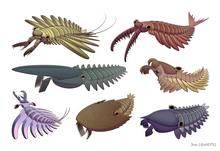
Back شعاعيات الأسنان Arabic Радиодонти Bulgarian Radiodonts Catalan Radiodonta German Radiodonta Spanish پرهدندانسانان Persian Radiodonta ID ラディオドンタ類 Japanese Radiodonta Dutch Radiodonta Portuguese
| Radiodonta Temporal range:
| |
|---|---|

| |
| Left to right, top to bottom: Amplectobelua symbrachiata, Anomalocaris canadensis, Aegirocassis benmoulai, Peytoia nathorsti, Lyrarapax unguispinus, Cambroraster falcatus, and Hurdia victoria | |
| Scientific classification | |
| Kingdom: | |
| Phylum: | |
| Class: | |
| Order: | †Radiodonta
Collins, 1996 |
| Families | |
| |
| Synonyms | |
|
Anomalocarida | |
Radiodonta (also known as radiodonts,[1][2][3] radiodontans,[4][5] radiodontids,[6] anomalocarids,[7] or anomalocaridids,[8][9][10] although the last two originally refer to the family Anomalocarididae, which previously included all species of this order but is now restricted to only a few species.[7]) is an extinct order of stem-group arthropods that was successful worldwide during the Cambrian period. Radiodonts are distinguished by their distinctive frontal appendages, which are morphologically diverse and were used for a variety of functions. Radiodonts were among the earliest large predators, but they also included sediment sifters and filter feeders.[11] Some of the most famous species of radiodonts are the Cambrian taxa Anomalocaris canadensis, Hurdia victoria, Peytoia nathorsti, Titanokorys gainesi, Cambroraster falcatus and Amplectobelua symbrachiata. The later surviving members include the subfamily Aegirocassisinae from the Early Ordovician of Morocco and the Early Devonian member Schinderhannes bartelsi from Germany.
- ^ Cong, Pei-Yun; Edgecombe, Gregory D.; Daley, Allison C.; Guo, Jin; Pates, Stephen; Hou, Xian-Guang (2018). "New radiodonts with gnathobase-like structures from the Cambrian Chengjiang biota and implications for the systematics of Radiodonta". Papers in Palaeontology. 4 (4): 605–621. doi:10.1002/spp2.1219. ISSN 2056-2802. S2CID 90258934.
- ^ Cite error: The named reference
:6was invoked but never defined (see the help page). - ^ Moysiuk, J.; Caron, J.-B. (14 August 2019). "A new hurdiid radiodont from the Burgess Shale evinces the exploitation of Cambrian infaunal food sources". Proceedings of the Royal Society B: Biological Sciences. 286 (1908): 20191079. doi:10.1098/rspb.2019.1079. PMC 6710600. PMID 31362637.
- ^ Cong, Peiyun; Daley, Allison C.; Edgecombe, Gregory D.; Hou, Xianguang (30 August 2017). "The functional head of the Cambrian radiodontan (stem-group Euarthropoda) Amplectobelua symbrachiata". BMC Evolutionary Biology. 17 (1): 208. doi:10.1186/s12862-017-1049-1. ISSN 1471-2148. PMC 5577670. PMID 28854872.
- ^ Cong, Peiyun; Daley, Allison C.; Edgecombe, Gregory D.; Hou, Xianguang; Chen, Ailin (September 2016). "Morphology of the radiodontan Lyrarapax from the early Cambrian Chengjiang biota". Journal of Paleontology. 90 (4): 663–671. doi:10.1017/jpa.2016.67. ISSN 0022-3360. S2CID 88742430.
- ^ Cite error: The named reference
collins1996was invoked but never defined (see the help page). - ^ a b Cite error: The named reference
vinther2014was invoked but never defined (see the help page). - ^ Cite error: The named reference
daley2009was invoked but never defined (see the help page). - ^ Cite error: The named reference
cong2014was invoked but never defined (see the help page). - ^ Van Roy, Peter; Daley, Allison C.; Briggs, Derek E. G. (2015). "Anomalocaridid trunk limb homology revealed by a giant filter-feeder with paired flaps". Nature. 522 (7554): 77–80. Bibcode:2015Natur.522...77V. doi:10.1038/nature14256. PMID 25762145. S2CID 205242881.
- ^ De Vivo, Giacinto; Lautenschlager, Stephan; Vinther, Jakob (28 July 2021). "Three-dimensional modelling, disparity and ecology of the first Cambrian apex predators". Proceedings of the Royal Society B: Biological Sciences. 288 (1955): 20211176. doi:10.1098/rspb.2021.1176. PMC 8292756. PMID 34284622.